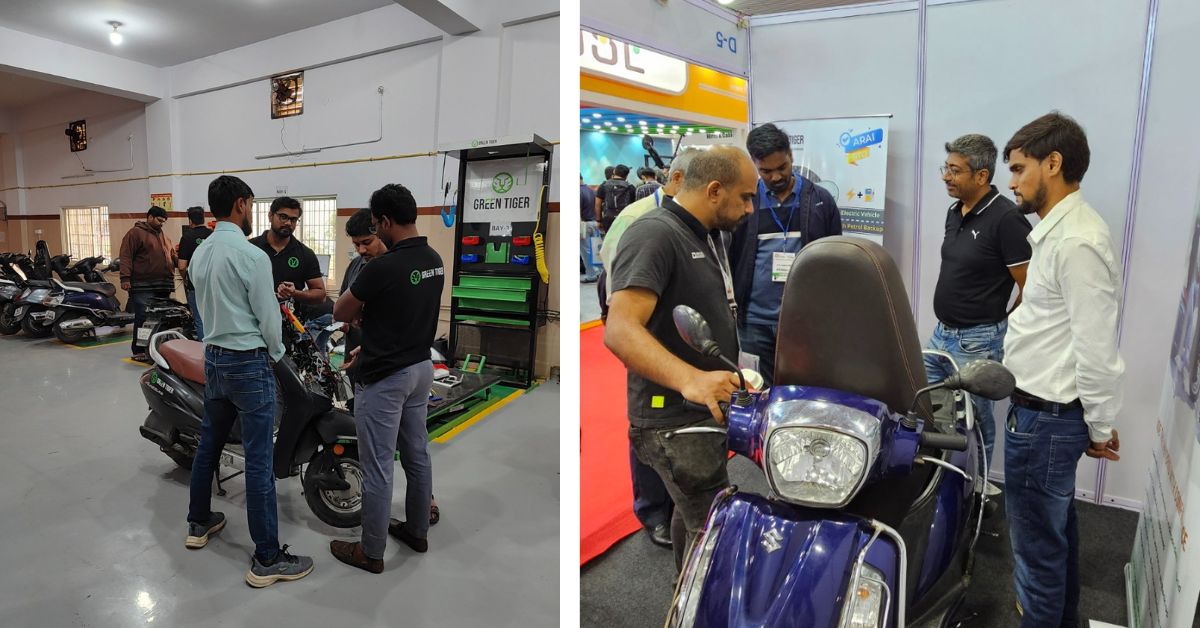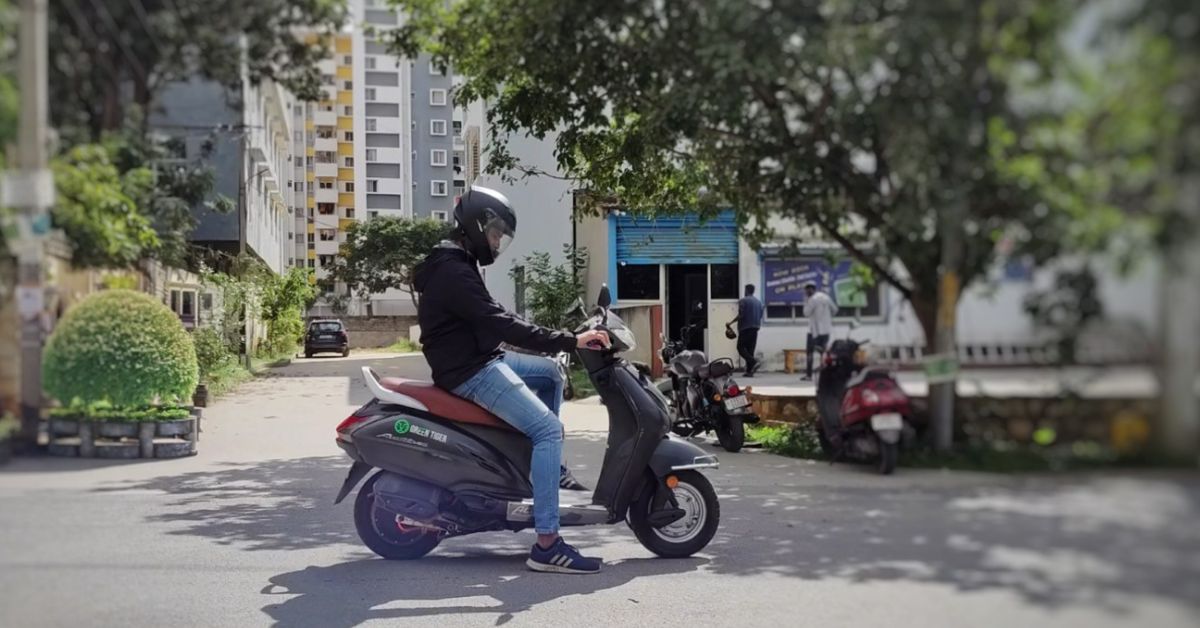With the concept of sustainability gaining popularity and people increasingly interested in making eco-friendly choices to reduce their carbon footprint, India has witnessed a surge in innovations.
From finding alternatives to single-use plastics to responsible tourism, India is experiencing a wave of cost-effective innovations in nearly every sector. Within the automobile industry, companies have introduced innovations in Electric Vehicles (EVs); however, many consumers still express concerns over its battery life, with lingering anxiety about reaching a charging point or their destination before it runs out.
However, Bengaluru’s Green Tiger Mobility employs a unique model which enables you to seamlessly transition between petrol and electric power within the same vehicle. To put it simply, the company converts your conventional petrol vehicle into a hybrid model, allowing it to operate on both petrol and electric batteries.
This means that you don’t have to worry about your battery running out mid-journey; you can easily switch to petrol. As the founder, Ashish Dokania, aptly puts it for The Better India, “It’s like having two scooters in one.”
The road to green mobility
Born and raised in a small town in Bihar, Ashish Donkaia had always been keen on building something on his own. Coming from a family of entrepreneurs, he says that the instincts were always there, but “I wanted to become an entrepreneur who can make a difference in the society.”
At the young age of 21, Ashish started a business in Bengaluru.
“I was very young and naive and could not really sustain it. I decided to close it down,” he explains. While the business had to be closed, it ignited a spirit in Ashish to run a successful business one day.

He pursued an MBA in Gurugram and started his career in the banking sector. “While working with the bank, I did a lot of project financing transactions, including a lot of infrastructure projects which kind of exposed me to renewable energy,” he shares.
By 2015, he joined another firm which worked along similar lines of renewable energy and solar energy. Working in the renewable energy sector for several years is what became one of the reasons why he perceived the idea of Green Tiger Mobility, adding to the long list of existing innovations like ‘battery swap’ and longer range in two-wheeler EVs.
“What I realised working in the sector was that with renewable energies that are dependent on nature, you cannot predict it as per your demand. In a country like India, where a lot of people are now moving towards EVs, there will soon be a huge gap in demand and supply of renewable electricity,” he says.
He continues, “This line of thought prompted me to consider a solution similar to the setup we employ in our homes, with electricity as the primary source and a generator or inverter as a backup. Why can’t we have an electric vehicle equipped with a petrol engine as a standby power source to ensure complete reliability for the consumer?”
This is how the idea of Green Tiger Mobility came to Ashish. “And that’s where we built the hybrid as a retrofit solution to give a bridge to 25 crore existing two-wheeler riders in the country towards a greener tomorrow,” he says.
So, in early 2020, Ashish decided to quit his 15 years of corporate career and finally bring his childhood dream to a living reality.
Presently, the company is present in Bengaluru and has converted over 50 vehicles into their hybrid models. Of those 25 were brought to the company by the consumers themselves. It has received ARAI & RTO approval to convert all major brands of scooters up to 125cc.
These converted vehicles have undergone rigorous testing, covering a total distance of one and a half to two lakh kilometres over the past 18 months.
Higher range, cheaper transition and additional features

The idea of Green Tiger Mobility lies in sustainability and eco-friendly business practices. “We already have companies producing EVs and petrol vehicles. However, there are already crores of vehicles on the road that could be converted into more greener vehicles,” he says.
Explaining the process of converting a regular petrol scooter into a ‘dual powertrain’, he says, “Our conversion process basically entails placing the entire motor, the entire electric powertrain, which is sitting on a petrol vehicle, without displacing the original petrol engine.”
“When you examine a typical scooter, you’ll notice that its engine is situated on the left-hand side at the rear, making the scooter inherently unbalanced and tilted towards the left. What our innovation involves is relocating the entire electric powertrain to the right side of the vehicle. This adjustment effectively rebalances the scooter, offering a more stable and balanced ride,” he adds.
Additionally, it comes with a controller and a smart display which indicates the amount of battery left and which mode the vehicle is running on.
“It also indicates if there is any fault in the system or if there is a heating problem while the vehicle is running on electric mode,” he says.
The dual powertrain mode or the retrofits are great not just because they are eco-friendly but it also reduces the anxiety of the rider over its range.
“On a daily basis, a typical rider only uses their scooter for a range of 50 to 60 km. It is only, let us say, once a month that they might need to use it for another 100 or 200 km. So instead of giving the consumer more range or battery swap, what we gave them is a reliable petrol engine that will cover any extra distance that you want to travel on a given day,” he adds.
This method, he adds, saves a lot of money that would otherwise be spent on petrol daily.

At present, the company is in the process of converting scooters from seven major brands, including Honda Activa, Honda Dio, Hero Maestro, Hero Pleasure, TVS Wego, TVS Jupiter, and Suzuki Access, all of which were registered on or after 2012. The conversion of motorcycles is currently in the testing phase and is slated for launch later this year.
As for the pricing of the process, Ashish puts it down in simple terms, “The battery and charger, when combined, amount to a total cost of Rs 35,000. The conversion itself costs Rs 20,000. Therefore, for the conversion, battery, and charger, the total comes to Rs 55,000.”
“Furthermore, there’s an option for the rider to upgrade to a smart system, which incurs an additional cost of Rs 5,000. By opting for the smart system, you gain access to a comprehensive telematics system, including accident alerts and vehicle disability notifications. Additionally, you can conveniently access all data related to your petrol and electric mobility on your mobile phone,” he adds.
The company has been slowly gaining traction and has 30 orders to convert in November 2023 alone.
Want to convert your vehicles? Check them out here.
(Edited by Padmashree Pande)
No comments:
Post a Comment